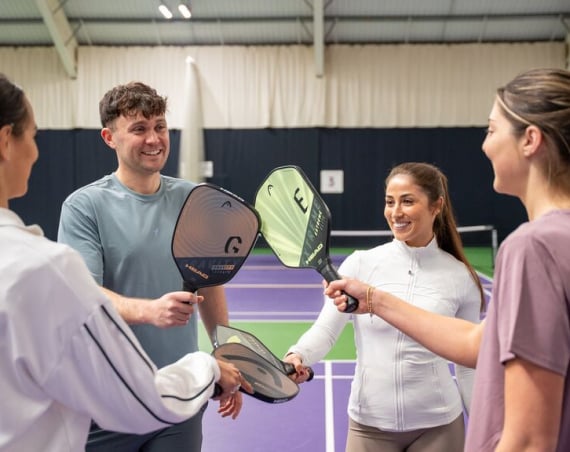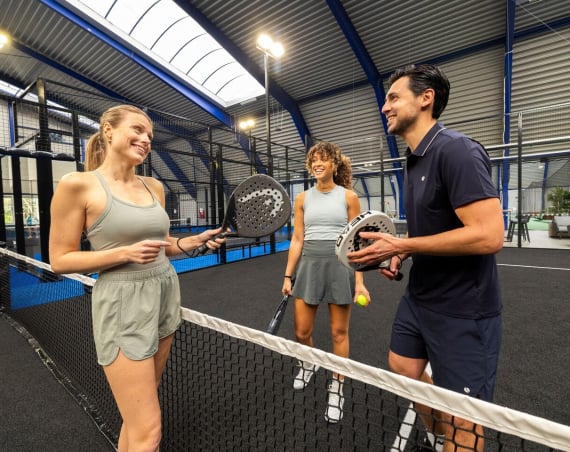Tennis players need high levels of cardiovascular fitness and strength. Both of these will help you compete and play an entire match without getting tired or picking up an injury. The sport demands short, explosive spurts of energy repeated over and over again throughout a match or training, and exertion is only punctuated by short breaks.
This, combined with the fact that tennis is one of the few sports that does not have a time limit (the game finishes when a certain number of sets are won), means competitive players need a mixture of both strong anaerobic skills, such as speed, agility and power, plus high aerobic capabilities.
This workout circuit, demonstrated by David Lloyd Beckenham Lead Coach, Adam Salter, will help to improve your speed, explosiveness and strength. With 13 different moves targeting the key areas of the body used in tennis, complete two to three circuits of each move at one of these levels:
INTERMEDIATE: 30 SECONDS PER EXERCISE WITH 30 SECONDS REST IN BETWEEN EACH SET. COMPLETE 2-3 CIRCUITS.
ADVANCED: 40 SECONDS PER EXERCISE WITH 20 SECONDS REST IN BETWEEN EACH SET. COMPLETE 3 CIRCUITS.
Move 1: Star Jumps
Plyometrics moves like star jumps will help you develop power through your torso and improve your movement when hitting those high shots. To do the move, squat down halfway and explode back up as high as possible. Fully extend your entire body, spreading your legs and arms away from the body. Try to spend as little time on the ground as possible when doing this move.
Move 2: Squat Jumps
Being able to jump and reach for those high shots demands powerful quads, and there is no better move to strengthen these than the squat jump. Starting with your feet positioned just outside of your hips, sink your hips back and down into a squat, then drive up strong through your heels. Use your arms for momentum before landing on the ground.
Move 3: Plyometric Lunges
The plyometric lunge will help to increase explosive power while strengthening the knee and ankle joints and helping to limit lower body injuries. It will also help to improve your overall bodily control and coordination. Jump your legs into a split stance, keep your upper body upright and your core engaged, lower your back knee towards the floor and then drive back up through your heels and switch your legs.
Move 4: Glute Bridges
These will improve your speed and explosiveness. To do a glute bridge, lie on your back with knees bent to 90 degrees, heels on the floor. Push your hips off the ground as high as you can and squeeze your glutes and hamstrings. Pause for a second, then lower again. Repeat. Increase difficulty by placing your feet up on a bench or doing one leg at a time.
Move 5: Ladder Climb
This will improve your footwork and agility. Starting at the baseline, move as quickly as you can down the line, stepping one foot after the other over the line in front of you, moving backwards and forwards over the line. Continue until you reach the service line. Sprint back to the starting position and repeat. Stay light on your toes and step as quickly and accurately as possible being careful not to touch the line.
Move 6: Overhead Medicine Ball Slams
When doing this move, make sure your core is braced the whole time – this will help to strengthen your abs and support your back. Holding the Med Ball, lift it up over your head, then forcefully throw it to the ground. Repeat. When picking the ball back up, make sure you bend your knees.
Move 7: Russian Twists
This move will strengthen the core and help protect your lower back from injury. Start in a seated position with knees bent and feet flat on the floor and hold one dumbbell with both hands in front of chest. Keeping the spine long and the abs braced, lean back slightly and lift your feet slightly off the floor. Slowly twist the torso to the left and bring the dumbbell beside the left hip. Return to the center, and then slowly twist to the right and bring the weight beside the right hip to complete one rotation. Repeat.
Move 8: Upright Row
The shoulders are absolutely key in every tennis stroke, so it goes without saying that they need to be strong. To do this move, use a barbell or dumbbells. Rest the weights on the top of your thighs with your arms extended, a slight bend in your elbows and a straight back. Exhale and use the sides of your shoulders to lift the bar, raising your elbows up and to the side. Keeping the bar close to your body, continue to lift the bar until it nearly touches your chin. Remember, your elbows should drive the move and should always be higher than your forearms. Lower the bar back down slowly to the starting position.
Move 9: Standing Military Press
This move will help to build strong shoulders. Picking up a barbell, make sure to grip the bar wider than shoulder width apart from each other. Slightly bend the knees and place the barbell on your collar bone. Lift the bar up over your head by locking your arms. Hold at about shoulder level and slightly in front of your head. Lower the bar down to the collarbone slowly as you inhale. Lift the bar back up to the starting position as you exhale. Repeat.
Move 10: Wrist Curls & Extensions
To best execute a stroke and prevent the racket head from being pushed off course, players need a strong grip. This is possible only through building a firm wrist. While standing with a shoulder width stance, hold a barbell down by your thighs, with a shoulder width, overhand grip. Using just your wrists (your arms should be extended and stationary in front of your body), curl the weight towards your body by flexing your wrists, then fully extend your wrists by doing a reverse curl.
Move 11: Bent Over Barbell Row
This move will strengthen your back. Start by holding a barbell with your palms facing down, bend your knees slightly and bring your torso forward, bending at the waist while keeping your back straight. The barbell should hang directly in front of you. While keeping your torso stationary, breathe out and lift the barbell towards you. At the top contracted position, squeeze the back muscles and hold for a brief moment. Inhale and slowly lower the barbell back to the starting position.
Move 12: Burpees
While burpees are a killer, they effectively work your arms, back, chest, core, glutes and legs in one. Building strength and endurance, they improve balance and co-ordination. Starting in a standing position, drop into a squat with your hands on the ground just in front of your feet. Kick your feet back behind you, keeping your arms extended so you are in a raised plank position. Jump back up and repeat.
Move 13: Mountain Climbers
A great move for building the upper body and core strength vital to tennis. Start in a plank position. Keep your abs squeezed tight and your body straight. Squeeze your glutes and pull your shoulders away from your ears. Pull your right knee into your chest, keeping your abs tight so your body doesn’t come out of plank position. Quickly switch and pull the left knee in. As you push your right leg back, pull your left knee in to the chest. Repeat.
Perform this circuit a couple of times a week, and you’ll be fit and ready for a competitive match of tennis in no time. If you need any help with your training, David Lloyd Clubs has brilliant tennis coaches and Personal Trainers who can help you on your journey. Visit your local David Lloyd Club to find out more.
This video was produced with the help of Adam Salter, Lead Coach at David Lloyd Clubs.






